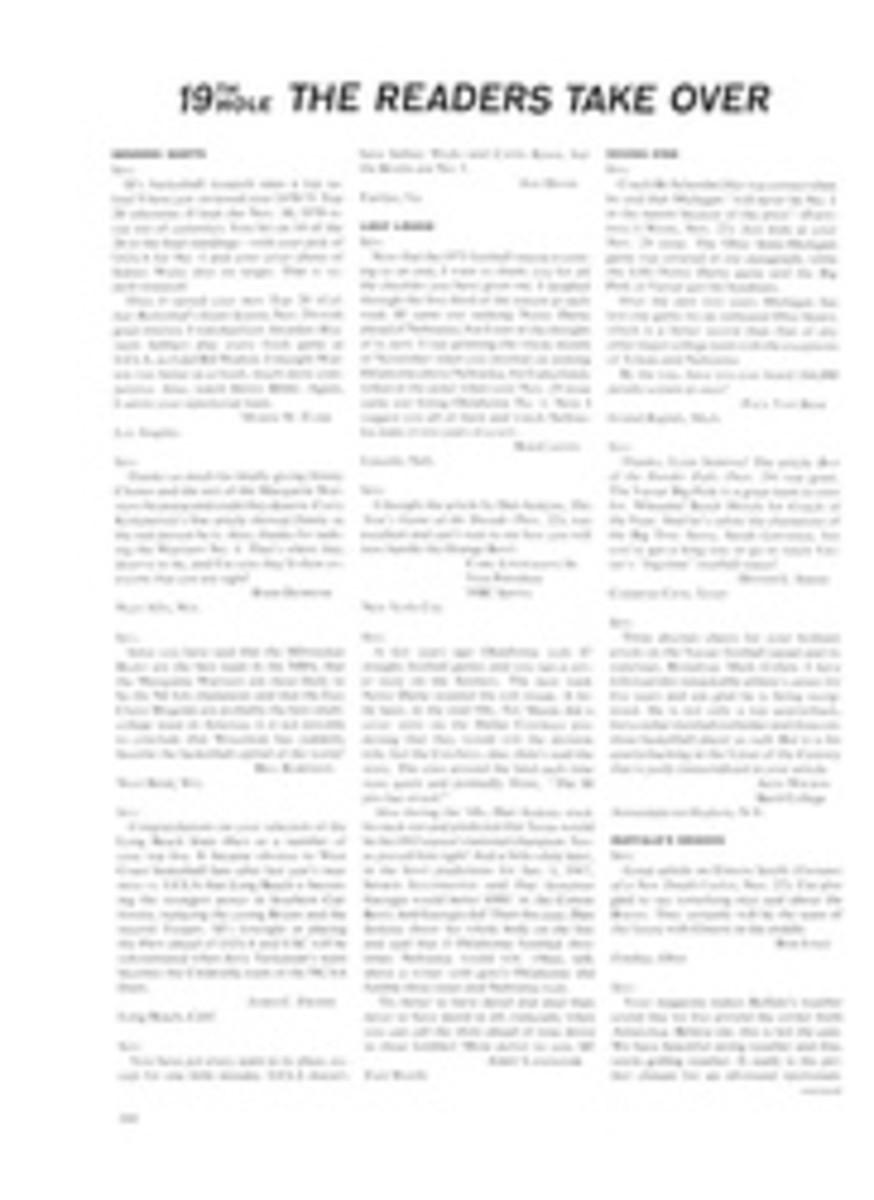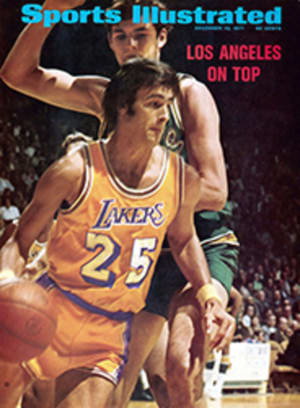
LOOK WHAT'S AFOOT
Greg Landry (left) is a quarterback with a strange fixation. He thinks he is Jimmy Brown. At least it seemed strange to the pros when he came to the Detroit Lions from the University of Massachusetts a few years ago and started running for 76 yards on quarterback draws and making NFL linebackers wish he would fall on his Wishbone. Now they're not so sure. Greg Landry may have something after all.
What he probably has is the pro offense of the future, only he has it right now. Going into last weekend's game, Landry was the 13th best rusher in the NFC with 455 yards, and his 7.6-yard average per carry was the best in the entire league, better than Larry Csonka's, better than Willie Ellison's, who set an alltime single-game record of 247 yards Sunday. Speaking of Sunday, in the Lions' 23-20 loss to Philadelphia, Landry scored two touchdowns while running the ball seven times for 42 yards and completed 14 of 23 passes for 230 yards.
It is this remarkable blend of hand and foot that makes Landry something special, the harbinger of things to come in pro football, the doomsayer of the last days of the dropback passer.
Coincidentally, two of the best of the dropbacks—or, as we may soon be calling them, throwbacks—Joe Namath and Bart Starr (pages 20-21), returned to action a couple of weeks ago, and Johnny Unitas, perhaps the best, started for the second time this season and was his old, archetypical self as the Colts beat the Raiders 37-14. But they may be among the last survivors of a breed that could go the way of the 325-pound middle guard.
"You are going to see a lot of big, running quarterbacks in the next few years," says Joe Schmidt, the head coach of the Lions. "The Wishbone is developing them, so there will be a supply. And a running quarterback really puts a load on the defense."
Schmidt has even installed option plays—the heart of the old split-T formation, the granddaddy of the Wishbone—to take advantage of Landry's running ability. While such quarterbacks as Roger Staubach and Fran Tarkenton are noted for their running, they are essentially scramblers—that is, they run when their receivers are covered or to elude a fierce pass rush. Landry, on the other hand, usually runs by design, calling his own number on the quarterback draw or going wide on the option, and with signal success.
The Lions are probably the only NFL team to use the option. "Steve Owens really makes it go," says Landry. "He keeps the defense honest on the inside. He freezes the linebackers when he fakes up the middle. Then when I swing out, I can either keep the ball or pitch out to Altie Taylor. It puts a terrific burden on the linebackers."
Wayne Walker, the veteran corner linebacker for the Lions, defended against the split T in college and knows as much about the option as anyone, but that is not enough. "There isn't any real answer to it yet," he says. "Especially when you have a quarterback who runs as well as Greg, It's a very disheartening thing for the defense."
The threat Landry poses actually transcends his ability to run. When he drops back to pass, he is far more than a passing threat, like Starr and Namath, for there is always the strong possibility that he will run.
"I was too anxious to run last year," he says. "Then Mike Lucci, our middle linebacker, pointed something out to me. I'd drop back, look for the primary receiver, then run. Lucci told me to wait, look for another receiver, then run. The longer I wait, the deeper the linebackers go with the receivers and the more room I have to run in. I've broken some long ones this year doing that."
"A running quarterback like Landry demoralizes a defense," Walker says. "Say it's third and six and he drops back to pass and your coverage is perfect. He tucks the ball away and runs for eight and the first down. Now you have done everything right, no one missed an assignment and still they got the first down. So after a while you start making adjustments and the adjustments leave gaps in the defense and he takes advantage of the gaps."
Chuck Knox, coach of the Lion offensive line, points out another benefit of having a running quarterback. "The defensive lines are so big and so quick now that a lot of clubs have to keep their running backs in to help protect the passer," he says. "That means you're only sending out three receivers into zone coverage, and they stand very little chance of getting open. But with Greg, the rush is inhibited by the chance he will run, so we can release our running backs into the passing patterns."
As of this year, the Cowboys, with Staubach, and the Saints, with Archie Manning, could utilize the option and the quarterback draw, but Manning has been injured much of the season and Dallas Coach Tom Landry, although an innovator in many respects, strongly disapproves of running quarterbacks.
"I like to run," Greg Landry says. "When I came up, Coach Schmidt used to tell me to stay in the pocket. I remember in one game last year I ran four or five times and when the game was over, he said, 'Greg, I told you not to run so much.' 'I know, Coach,' I said. 'I'm sorry.' He looked at me for a minute, then he said, 'If you keep it up, we'll do something to stop it.' "
The following week, despite Schmidt's warning, Landry ran seven times and gained 77 yards. After the game, which the Lions won, Schmidt cornered him. "I said, 'I didn't mean to run, Coach,' " says Landry. "He said, 'You remember what I said last week?' I nodded, figuring he was going to get on me again, but he just grinned and said, 'Well, forget it. Run whenever you want to.' "
When he was an All-Conference quarterback at Massachusetts, Landry ran about as often as he threw the ball. His indoctrination into the complexity of attacking a pro defense came when he played for the College All-Stars against the Packers in 1968, and his coach in that game was one of the nonrunningest quarterbacks in the history of pro football, Norman Van Brocklin, now the Atlanta coach.
Van Brocklin, however, did not try to inhibit Landry, a big youngster who looks so much like Gomer Pyle that the Lions have nicknamed him Gomer—to his disgust. He is remarkably self-confident for a 24-year-old in his fourth season, a quality he may have picked up from Van Brocklin, who exudes it.
"I remember one thing about that All-Star Game," says Landry. "I hit Charlie Sanders between two defensive backs and I had to drill the ball low, so there wouldn't be any chance of an interception. When I came to the sidelines after we had to punt, Van Brocklin patted me on the back. 'Hell of a pass, kid,' he told me. 'There's only one other quarterback I know who could have completed that pass.' 'Who's that?' I said. 'You're looking at him,' he said."
Landry, of course, has a good arm as well as two good legs; as of Sunday's game, he was the second-leading passer in the NFC. He is also the sneakiest pro quarterback ever, a distinction he gained last season against the Packers. "We were way ahead of Green Bay," he says. "We had the ball on our own 13-yard line and I was just trying to run out the clock. I had called a quick toss to the right in the huddle, but when I got to the line of scrimmage I saw Jim Carter, playing middle linebacker, moving over to his left to stop the play. So I thought to myself, 'What the heck, why not gamble a little.' "
Landry called a sneak, whipped through a wide hole in the Packer line, shrugged off two tackles and was away.
"I chugged 76 yards," he says. "The last 10 yards I heard this guy on my shoulder and I knew he was thinking, 'Why doesn't he hurry up and get this over with!' We fell down together from exhaustion on the Green Bay 11."
Like many a defensive lineman, Landry stands in awe of Tarkenton, the Giant water bug. "I could never run around from sideline to sideline the way Fran does," he says. "In the first place, I'd probably run out of breath and in the second place, I'm not as quick as he is and I don't think I could get away with it."
When Landry runs, he runs forward, but he is not too fond of running up the middle, despite his success with the sneak. "You don't know where the trouble is coming from when you go up the middle," he says. "The coaches want me to run along the sidelines so that I know where it's coming from, and I can get out of bounds if I have to. I'm not going to run over anyone and I don't have really exceptional speed, but I have broken some long gains because the defense has to respect the threat of Owens up the middle and that opens some pretty big gaps for me.
"John Brodie taught me one big lesson," he says. "I used to hear the crowd when they booed me and they would when I was having a bad day. It would get to me and I'd do things like throwing a bomb when I shouldn't or cutting down on my passing if I'd had a few in-completions in a row. But John told me how the fans in San Francisco used to get on him. He said you have to shut out the crowd noise, cheers or boos, and that when you learn to do that. you've got it made. Well, I've learned to do it now and I don't even hear the crowd anymore."
Fortunately, Landry has heard very few boos this season; he is playing out his option and he feels that his performance so far has buttressed his demands for more money. "I was just about to sign when the freeze came on," he says. "At first I was upset but now I think that it has worked to my advantage. Before this season I hadn't proved I had the ability to lead the team, and they said I lacked experience. Now that I've shown what I can do I don't think we'll have any trouble reaching an agreement."
No matter what they pay Landry, the Lions will get a run for their money.
PHOTO
PHOTO
Halfback Taylor spectates as Landry scores.

